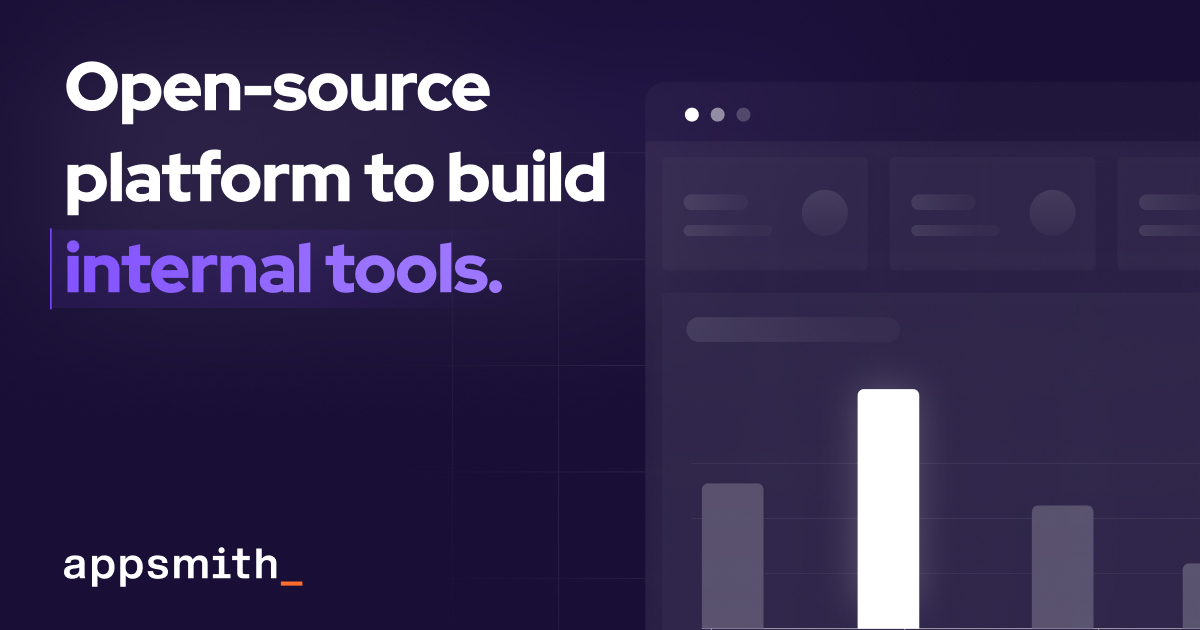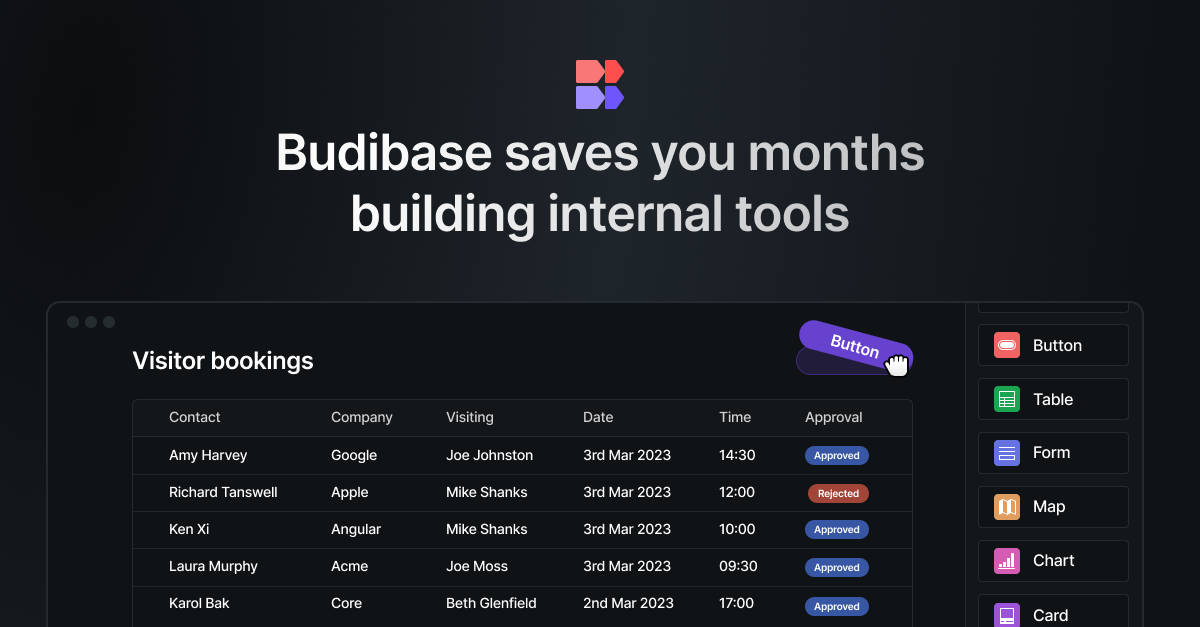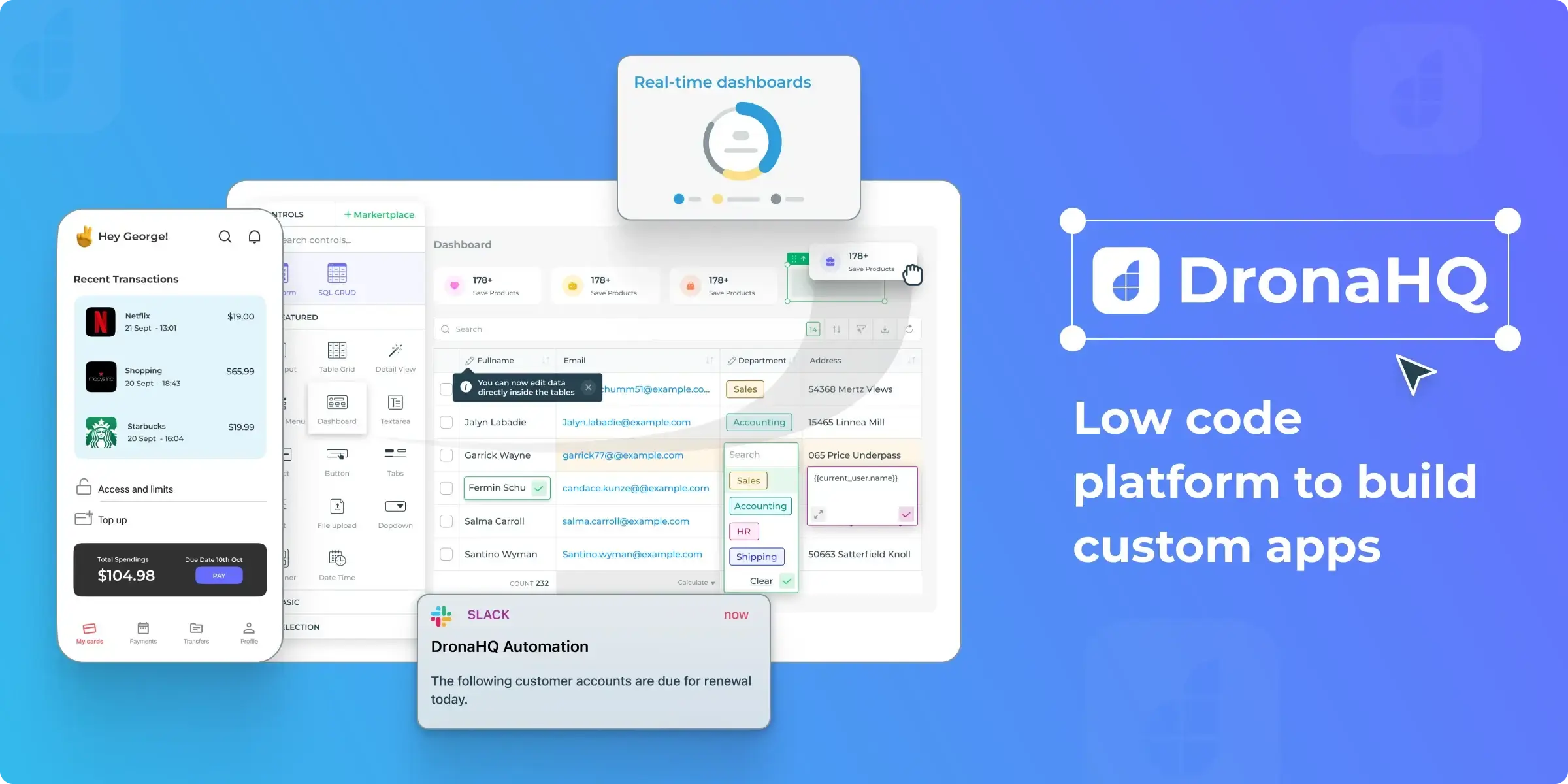Low-code is a software development paradigm that facilitates and accelerates software creation by offering visual app-building functionalities, code abstractions, and developer productivity tools.
In our Low-code series, we review the best low-code development platforms in the business. And another low-code tool in our list is UI Bakery.
It’s a promising internal software builder supported by a dedicated developer team and a number of businesses driving profits from using it. But enough introductions, let’s find out what makes UI Bakery a good choice for low-code app development.
What is UI Bakery?
UI Bakery is a low-code development platform and a company based in Lithuania. It was founded in December 2018 by a team of software developers led by Vladimir Lugovsky. The platform grabbed the attention of the low-code development community with great performance, advanced functionalities, and scalability.
Today, UI Bakery is a top solution for building your web-based business apps fast and integrating them with multiple APIs, third-party systems, and other sources.
Users like the platform for the large variety of pre-made UI components and simplicity, thanks to the drag-and-drop interface.
Above that, UI Bakery offers customization opportunities for professional developers that allow them to create custom UI elements, API integrations, and app business logic.
It provides developers with a wide range of solutions to create complex workflow automation apps, stable and aesthetic front-ends, and web-based products.
Target audience of this low-code platform
UI Bakery is positioned as a platform that bridges the gap between full-code and no-code solutions.
It is designed for a range of users who need to build business apps, admin panels, dashboards, and business applications quickly and efficiently.
All this is possible without specific technical knowledge, as users do not need to write a lot of code for solving standard tasks.
UI Bakery has the following main target groups:
- Developers. UI Bakery allows them to build UIs fast without focusing on design. Instead, they can concentrate more on backend logic and data.
- Technical teams in startups and SMEs. UI Bakery offers a cost-effective way to create internal apps without hiring frontend programmers or waiting for long development cycles.
- Enterprise IT departments. Such teams often look for the most feasible approach to digitizing internal processes, handling access control, and managing scale. The use of UI Bakery can be a great support in achieving such goals. It offers role-based access control, audit logs, custom domains, and security features to work with sensitive data.
- Citizen developers (with no or minimal technical expertise). UI Bakery provides such users with access to prebuilt templates and integrations that can be implemented with minimal or no code. Though non-technical users can rely on UI Bakery in app development, when it comes to more complex cases, coding knowledge is required.
Main features of UI Bakery
Let's have a closer look at what UI bakery can offer to businesses.
User interface
UI Bakery includes multiple no-code functionalities accessible for the non-technical business staff to develop digital tools in a matter of hours.
That is possible thanks to the drag-and-drop interface, embedded with 80+ out-of-box components like charts, tables, and graphics, and adjusting the apps’ interfaces with CSS. WYSIWYG HTML editor also facilitates the frontend development of an internal web application.
At the same time, professional programmers will find a set of features to build custom templates and connectors fast, or even take JS components published on a CDN.
Among the list of developer tools, UI Bakery offers version control, smart code suggestions, and team collaboration tools.
Integrations
The platform has a great number of connectors for the world’s most popular databases, BPM systems, and collaboration tools.
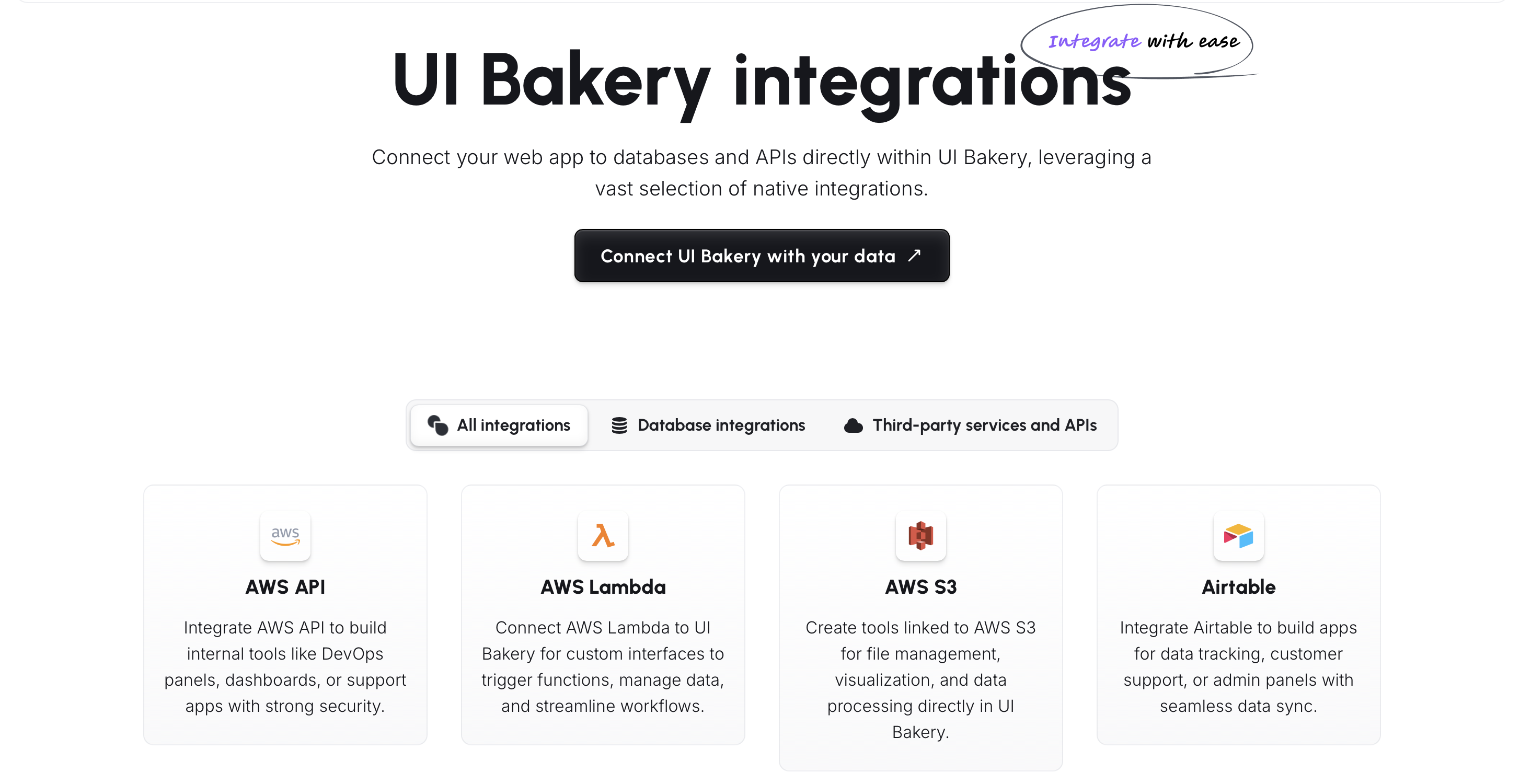
UI Bakery applications are capable of centralizing the data from multiple sources and provide features to change it from a single interface.
You can integrate REST and GraphQL APIs using the Postman-like interface and curl shortcuts. UI Bakery's tools can filter, group, and join data from multiple sources.
Here are some examples of the integrations supported by UI Bakery:
- SQL databases: MySQL, PostgreSQL
- NoSQL databases: Firebase, MongoDB
- APIs: REST APIs, GraphQL APIs
- Communication: Slack
- Payments: Stripe
- Cloud services: AWS, Google Sheets
- CRM and analytics: HubSpot, Salesforce
Customization capacity
You can create custom UI elements for your internal tool using JavaScript. For the convenience of developers, there are lots of tools and features like IDE, version history, SSO integrations, etc.
You can also write custom queries to derive data from various sources at the same time. Besides, UI Bakery has AI suggestions for custom queries that speed up the coding.
Another feature that makes UI Bakery stand out from similar alternatives is white labeling. Thus, you are able to put your brand signs on the app instead of the platform’s ones.
Use cases
As we mentioned, the application field of UI Bakery revolves around internal tools, business operations automation, and workflow optimization.
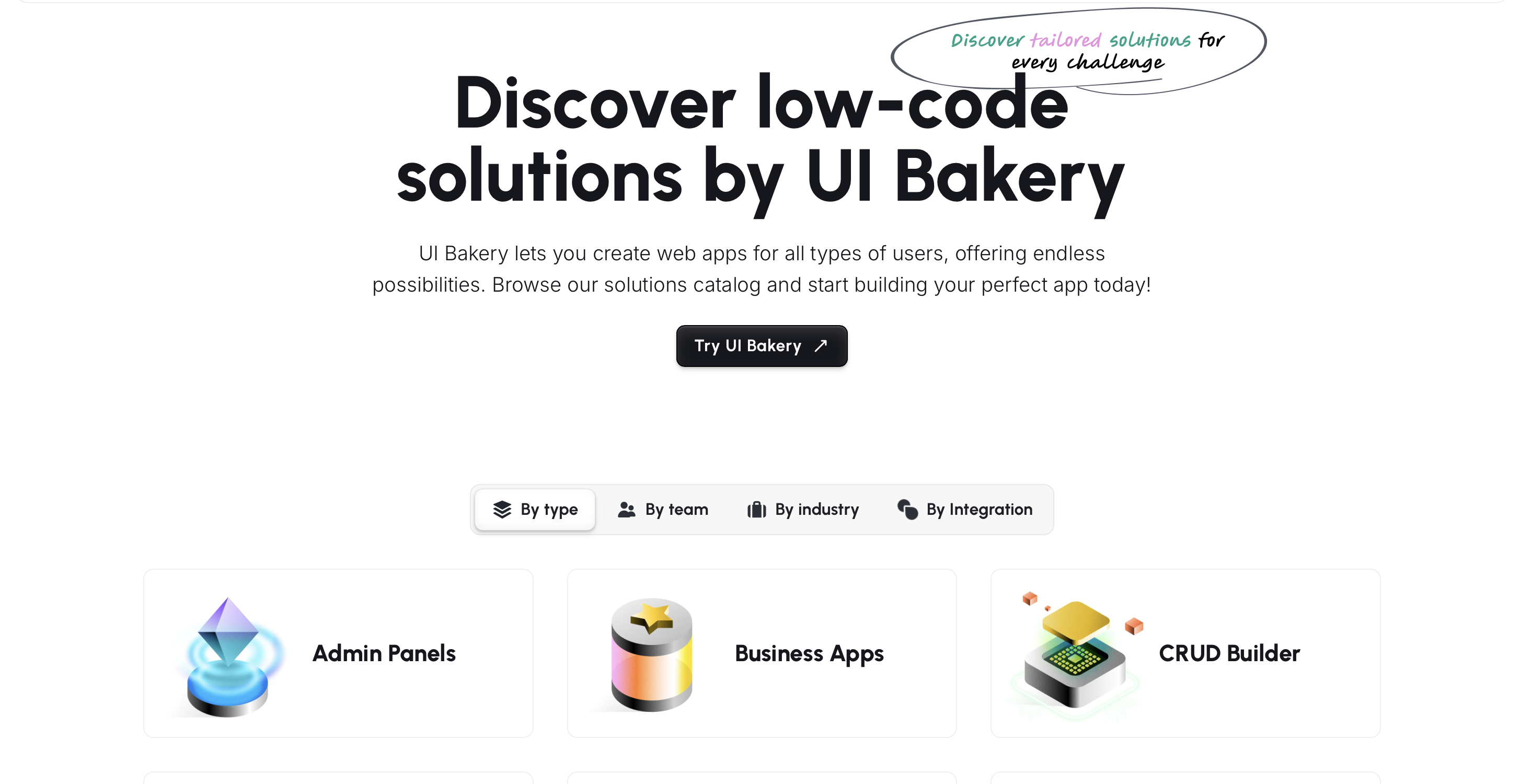
With Bakery, you can create multi-step workflows for simple ETL operations, alerting, and data synchronization across multiple sources.
The workflows and business tools are able to use data from HTTP APIs, SQL databases, Google Spreadsheets, CRMs, and other sources.
To build sophisticated solutions, you can apply loops, conditional business logic, and asynchronous operations.
The platform will be a great way to supplement your existing BPM system and internal workflow. You can connect Bakery’s internal applications with your existing business system to extend its capabilities, owing to pre-built connectors.
Workflow integrations are token-secured, so you won’t need to worry about your data while it transfers between your system’s elements.
Pricing
Before we proceed to pricing, it's worth mentioning that UI Bakery offers cloud and self-hosting options, and the same pricing plans are available in both cases.
Moreover, users of paid plans can enjoy a 20% discount when they choose to be billed annually.
Free plan: €0
The free plan includes the required features and templates to build simple data representation applications. It offers the possibility to build unlimited apps and pages. Nevertheless, the number of developers is restricted to 5.
Standard plan: €4 per month per user, €9 per month per developer (if billed annually)
In addition to everything that is available in the free plan, this option allows teams to add more than 5 users, assign user roles, as well as view release history. Moreover, users can rely on the assistance of the online support team.
Business plane: €9 per month per user, €35 per month per developer (if billed annually)
This pricing tier includes such features as custom themes, custom user roles, and audit logs.
Business Unlim plan: €230 per month for unlimited users, €35 per month per developer
This pack will match the needs of a large business and an enterprise. Among the key benefits of the Unlim plan, we should name an unlimited number of seats.
Enterprise: Custom pricing
It includes all the power of the UI Bakery platform and beyond. It is a very good choice for large enterprises that require heavy customization and advanced functionality, including white-labelling, Git integration and version-control, embedded apps, etc.
In addition to this, the Enterprise plan also covers dedicated support, as well as app development and migration services.
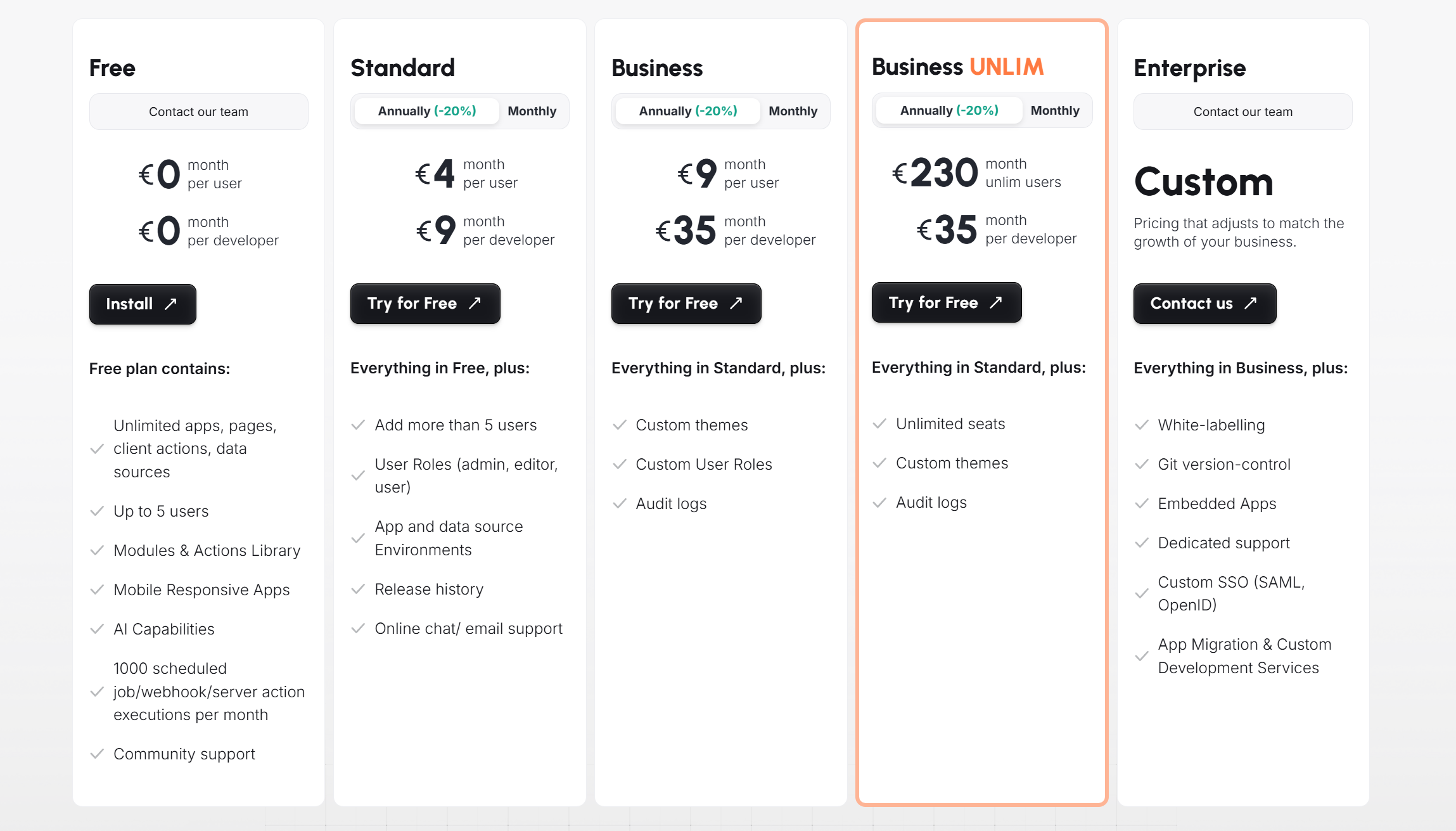
UI Bakery Pros & Cons
If you are trying to find out whether UI Bakery is a good choice for you, it will be helpful to take a closer look at its strengths and weaknesses.
UI Bakery Benefits
Intuitive and functional UI building interface. It offers a clean drag-and-drop editor with grid layout control and a rich set of widgets, including tables, charts, forms, modals, buttons, etc.
Apart from this, real-time preview, responsive design gear, and smart element alignment make UI creation efficient and fast.
Unlimited app pages. There are no caps on how many pages or views you can create per app. Therefore, it is well-suited for building multi-section dashboards, customer portals, or process-heavy applications.
Easy integration with different sources. UI Bakery offers native support for SQL databases, REST APIs, GraphQL, Firebase, Airtable, etc. Thanks to the process of connecting data sources is pretty simple and fast. Authentication headers and variable substitution are built-in.
Evolving library of UI templates and out-of-box connectors. Businesses can rely on prebuilt templates for common use cases, like CRM dashboards, ticketing systems, etc. In addition to this, out-of-the-box connectors reduce setup time dramatically.
Comprehensive documentation with step-by-step written guides and videos. Though UI Bakery has its peculiarities that should be studied before developers proceed to their first project, the availability of various learning resources significantly facilitates this task.
Good customer service and active community. A responsive support team provides its services via chat and email. Besides this, in the case of any questions, developers can turn to the community.
UI Bakery Disadvantages
Basic web development knowledge needed. UI Bakery is not a pure no-code solution. Without tech expertise, users can deal only with the most basic tasks.
For working with more complex projects, it will be essential to know basic JavaScript and REST API concepts, as well as understand how databases and queries work. Non-technical users may also find UI Bakery steep at first, especially when setting up workflows or custom logic.
Limited possibilities for building public-facing apps. UI bakery is primarily optimized for internal solutions, not for consumer-facing websites or apps. It may not be the best option for apps that require user authentication at scale or custom user journeys (like marketplaces).
Offline/native mobile support not available. UI Bakery is strictly web-based. It doesn't provide support for building native iOS/Android apps or offline functionality.
UI Bakery alternatives
Although UI Bakery will solve almost all your internal workflow issues and improve customer service, you might need to consider using other alternatives.
On our blog, you can find articles where we talk about different platforms, their features, integrations, pros, and cons.
Verdict
All in all, UI Bakery is one of the best platforms in the class of business app builders. The abundance of pre-made components and a beginner-friendly user interface allow citizen developers to create performant and functional software apps.
Even if you have no particular experience in software development, UI Bakery will allow you to start building and deploying workflow automation tools, collaboration apps, and web-based internal apps in a matter of hours.
The more advanced developers familiar with JavaScript will open the more complex dimension of the platform.
Using the JavaScript programming language, you can create custom features and integrations to develop the exact system you need for your business.
Also, you can go beyond the limits and contact the UI Bakery team for enterprise solutions, where developers will build the needed features right for your project.
When to use UI Bakery
- When you need to deploy tools for internal use, dashboards and admin panels and you should do it quickly;
- When you want to automate workflows, connect data sources to one system, synchronize data across solutions (and the security of your data is a priority for you);
- When it is necessary to extend vendor or B2B applications with custom UIs;
- When both technical and non-technical team members should be involved;
When UI Bakery may not be the best fit
- When you are building consumer‑facing apps;
- When you need offline or native mobile support;
- When you want to have full UI control comparable to a dedicated front-end framework.
What users think about UI Bakery
Since its introduction, this platform has helped thousands of businesses to streamline their internal business processes and create workflow automation services quickly and effectively.
UI Bakery is highly appreciated by the development community and has a 4.7-star rating on G2. The team is rapidly evolving the platform to be the best experience for citizen developers and professionals.
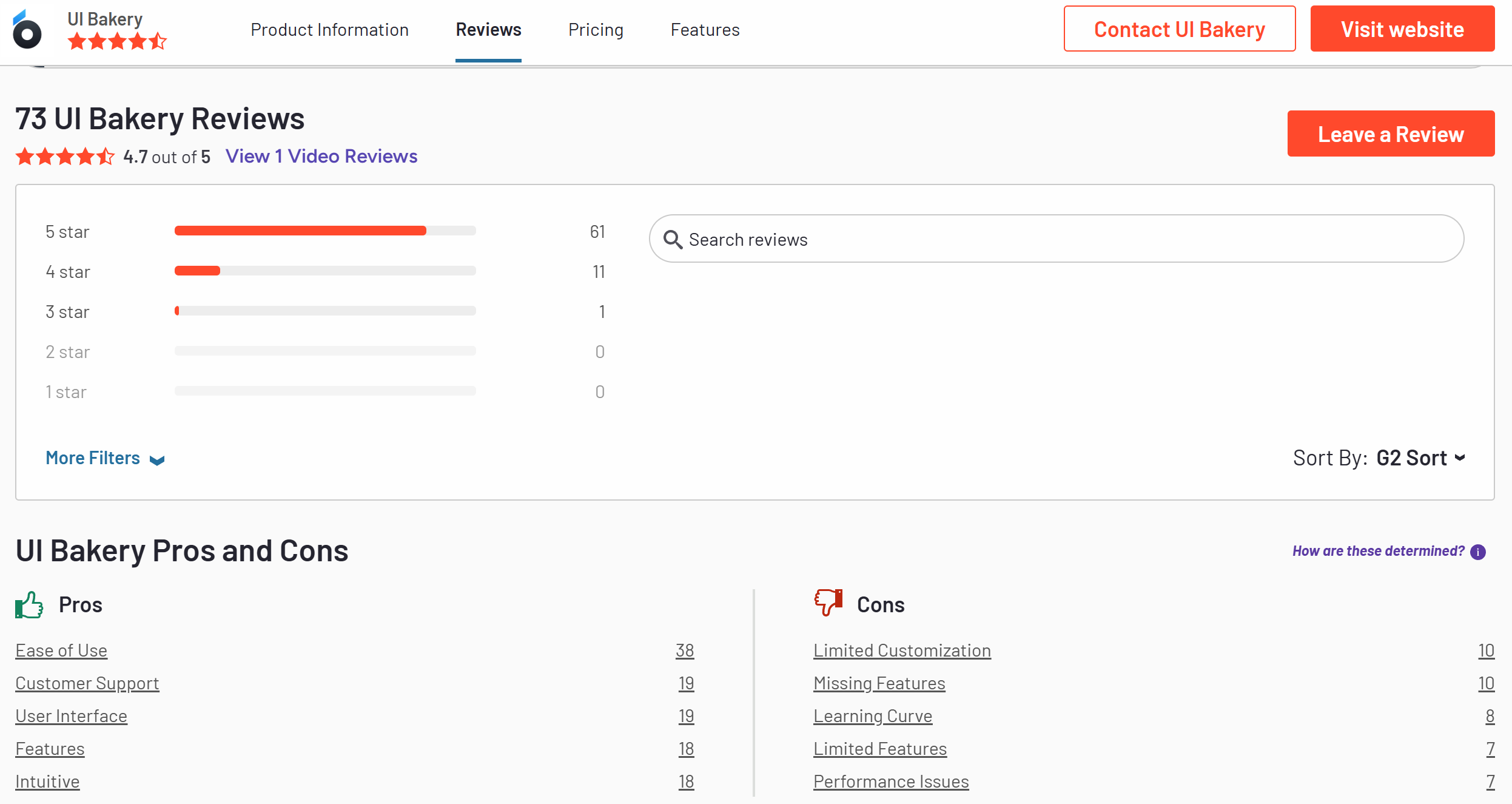
Many users, especially those with coding experience, find UI Bakery's interface comfortable and efficient. It enables users to build applications swiftly.
For instance, a user mentioned creating a dashboard with multiple data sources in just a few hours, appreciating the platform's speed and responsiveness.
Users commend UI Bakery's ability to integrate effortlessly with various data sources, including APIs and databases. This integration capability streamlines the process of connecting and managing data within applications.
Good customer service is also a strong side of UI Bakery. Its support team is frequently praised for their responsiveness and effectiveness. Users report quick resolutions to issues, often within hours, and appreciate the team's willingness to assist with custom solutions.
Nevertheless, there are also some points that may encourage companies to look for alternatives. One of them is pricing. Some users believe that fees could be lower.
Apart from this, while UI Bakery provides a range of pre-built features and templates, some users have found the customization options to be limited for more complex UI designs. Advanced features may require additional coding or may not be fully supported.
Besides that, users have reported performance lag when building large applications with multiple pages and elements.
Low-code development experts
There’s no faster and easier way to develop your business application or internal workflow optimization software than by using a low-code approach.
No-code and low-code platforms make software creation available, affordable, and easy for all businesses (SMEs, startups, and enterprises) and individuals alike.
But usually, to access all the benefits of such technologies, you may need professional developer assistance that has experience using these platforms.
You can discuss your project with our experts if that is your case.
We have more than 10 years of software development experience and have been actively working with various low-code products during this period. Some of our specialists even participated in the creation of one of such platforms.
We can help you at any stage of your project: from the right low-code platform selection (with feasible pricing and required features) and process strategizing to full-scale app development and integration with your existing systems.
For more information, reach out to our team and get a free consultation.
{{form}}
Streamlining Gifting Marketplace Operations with Retool
Afloat, a gifting marketplace, needed custom dashboards to streamline order management, delivery tracking, and reporting while integrating with Shopify and external APIs.
The solution:
We built two Retool-based dashboards:
- A Retail Partner Dashboard embedded into Shopify for managing orders and store performance.
- An Admin Dashboard for handling deliveries and partner data.
Both dashboards included real-time integration with Afloat's Backend and APIs for accurate, up-to-date data and scalability.
The result: enhanced efficiency, error-free real-time data, and scalable dashboards for high-order volumes.
Billing Automation for a SaaS Company with Low-Code
Our client needed a robust billing solution to manage hierarchical licenses, ensure compliance, and automate invoicing for streamlined operations.
The solution:
We developed a Retool-based application that supports multi-tiered licenses, automates invoicing workflows, and integrates seamlessly with CRM and accounting platforms to enhance financial data management.
The result:
- Achieved 100% adherence to licensing agreements, mitigating penalties.
- Automated invoicing and workflows reduced manual effort significantly.
- Dashboards and reports improved decision-making and operational visibility.
Retool Dashboards with HubSpot Integration
Our client needed a centralized tool to aggregate account and contact activity, improving visibility and decision-making for the sales team.
The solution
We built a Retool application integrated with HubSpot, QuickMail, and Clay.com. The app features dashboards for sorting, filtering, and detailed views of companies, contacts, and deals, along with real-time notifications and bidirectional data syncing.
The result
- MVP in 50 hours: Delivered a functional application in just 50 hours.
- Smarter decisions: Enabled data-driven insights for strategic planning.
- Streamlined operations: Reduced manual tasks with automation and real-time updates.
Lead Generation Tool to Reduce Manual Work
Our client, Afore Capital, a venture capital firm focused on pre-seed investments, aimed to automate their lead generation processes but struggled with existing out-of-the-box solutions. To tackle this challenge, they sought assistance from our team of Akveo Retool experts.
The scope of work
The client needed a tailored solution to log and track inbound deals effectively. They required an application that could facilitate the addition, viewing, and editing of company and founder information, ensuring data integrity and preventing duplicates. Additionally, Afore Capital aimed to integrate external tools like PhantomBuster and LinkedIn to streamline data collection.
The result
By developing a custom Retool application, we streamlined the lead generation process, significantly reducing manual data entry. The application enabled employees to manage inbound deals efficiently while automated workflows for email parsing, notifications, and dynamic reporting enhanced operational efficiency. This allowed Afore Capital's team to focus more on building relationships with potential founders rather than on administrative tasks.
Retool CMS Application for EdTech Startup
Our client, CutTime, a leading fine arts education management platform, needed a scalable CMS application to improve vendor product management and user experience.
The scope of work
We developed a Retool application that allows vendors to easily upload and manage product listings, handle inventory, and set shipping options. The challenge was to integrate the app with the client’s system, enabling smooth authentication and product management for program directors.
The result
Our solution streamlined product management, reducing manual work for vendors, and significantly improving operational efficiency.
Building Reconciliation Tool for e-commerce company
Our client was in need of streamlining and simplifying its monthly accounting reconciliation process – preferably automatically. But with a lack of time and low budget for a custom build, development of a comprehensive software wasn’t in the picture. After going through the case and customer’s needs, we decided to implement Retool. And that was the right choice.
The scope of work
Our team developed a custom reconciliation tool designed specifically for the needs of high-volume transaction environments. It automated the processes and provided a comprehensive dashboard for monitoring discrepancies and anomalies in real-time.
The implementation of Retool significantly reduced manual effort, as well as fostered a more efficient and time-saving reconciliation process.
Creating Retool Mobile App for a Wine Seller
A leading spirits and wine seller in Europe required the development of an internal mobile app for private client managers and administrators. The project was supposed to be done in 1,5 months. Considering urgency and the scope of work, our developers decided to use Retool for swift and effective development.
The scope of work
Our developers built a mobile application tailored to the needs of the company's sales force: with a comprehensive overview of client interactions, facilitated order processing, and enabled access to sales history and performance metrics. It was user-friendly, with real-time updates, seamlessly integrated with existing customer databases.
The result? Increase in productivity of the sales team and improved decision-making process. But most importantly, positive feedback from the customers themselves.
Developing PoC with Low Code for a Tour Operator
To efficiently gather, centralize, and manage data is a challenge for any tour operator. Our client was not an exception. The company was seeking to get an internal software that will source information from third-party APIs and automate the travel itinerary creation process. Preferably, cost- and user-friendly tool.
The scope of work
Our experts ensured the client that all the requirements could be covered by Retool. And just in 40 hours a new software was launched. The tool had a flexible and easy-to-use interface with user authentication and an access management system panel – all the company needed. At the end, Retool was considered the main tool to replace the existing system.
Testing New Generation of Lead Management Tool with Retool
Our client, a venture fund, had challenges with managing lead generation and client acquisition. As the company grew, it aimed to attract more clients and scale faster, as well as automate the processes to save time, improve efficiency and minimize human error. The idea was to craft an internal lead generation tool that will cover all the needs. We’ve agreed that Retool will be a perfect tool for this.
The scope of work
The project initially began as a proof of concept, but soon enough, with each new feature delivered, the company experienced increased engagement and value.
We developed a web tool that integrates seamlessly with Phantombuster for data extraction and LinkedIn for social outreach. Now, the company has a platform that elevates the efficiency of their lead generation activities and provides deep insights into potential client bases.
Building an Advanced Admin Portal for Streamlined Operations
Confronted with the need for more sophisticated internal tools, an owner of IP Licensing marketplace turned to Retool to utilize its administrative functions. The primary goal was to construct an advanced admin portal that could support complex, multi-layered processes efficiently.
The scope of work
Our client needed help with updating filters and tables for its internal platform. In just 30 hours we've been able to update and create about 6 pages. Following features were introduced: add complex filtering and search, delete records, styling application with custom CSS.
Together, we have increased performance on most heavy pages and fixed circular dependency issues.
Creating MVP Dashboard for Google Cloud Users
Facing the challenge of unoptimized cloud resource management, a technology firm working with Google Cloud users was looking for a solution to make its operations more efficient. The main idea of the project was to create an MVP for e-commerce shops to test some client hypotheses. Traditional cloud management tools fell short.
The scope of work
Determined to break through limitations, our team of developers turned Retool. We decided to craft an MVP Dashboard specifically for Google Cloud users. This wasn't just about bringing data into view; but about reshaping how teams interact with their cloud environment.
We designed a dashboard that turned complex cloud data into a clear, strategic asset thanks to comprehensive analytics, tailored metrics, and an intuitive interface, that Retool provides. As the results, an increase in operational efficiency, significant improvement in cost management and resource optimization.
Elevating CRM with Custom HubSpot Sales Dashboard
Our other client, a SaaS startup, that offers collaborative tools for design and engineering teams, was on a quest to supercharge their sales efforts. Traditional CRM systems were limited and not customizable enough. The company sought a solution that could tailor HubSpot to their workflow and analytics needs.
The scope of work
Charged with the task of going beyond standard CRM functions, our team turned to Retool. We wanted to redefine how sales teams interact with their CRM.
By integrating advanced analytics, custom metrics, and a user-friendly interface, our developers provided a solution that transformed data into a strategic asset.
In 40 hours, three informative dashboards were developed, containing the most sensitive data related to sales activities. These dashboards enable our customer to analyze sales and lead generation performance from a different perspective and establish the appropriate KPIs.
Building a PDF Editor with Low-Code
Our client, a leading digital credential IT startup, needed a lot of internal processes to be optimized. But the experience with low-code tools wasn’t sufficient. That’s why the company decided to hire professionals. And our team of developers joined the project.
The scope of work
The client has a program that designs and prints custom badges for customers. The badges need to be “mail-merged” with a person’s info and turned into a PDF to print. But what is the best way to do it?
Our developers decided to use Retool as a core tool. Using custom components and JavaScript, we developed a program that reduced employees' time for designing, putting the data, verifying, and printing PDF badges in one application.
As a result, the new approach significantly reduces the time required by the internal team to organize all the necessary staff for the conference, including badge creation.


.png)






